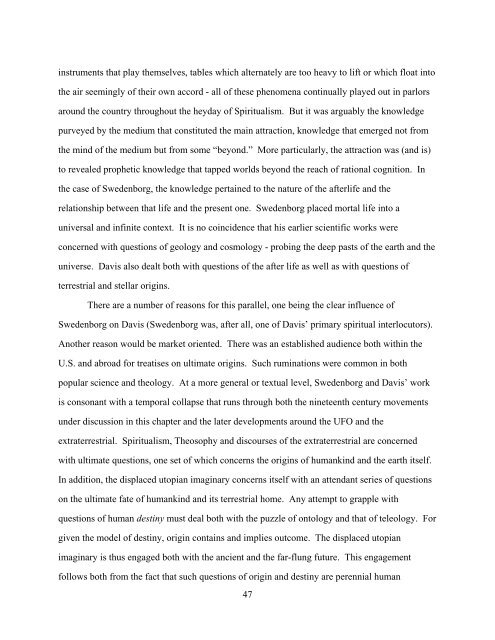A Genealogy of the Extraterrestrial in American Culture
A Genealogy of the Extraterrestrial in American Culture
A Genealogy of the Extraterrestrial in American Culture
Create successful ePaper yourself
Turn your PDF publications into a flip-book with our unique Google optimized e-Paper software.
<strong>in</strong>struments that play <strong>the</strong>mselves, tables which alternately are too heavy to lift or which float <strong>in</strong>to<br />
<strong>the</strong> air seem<strong>in</strong>gly <strong>of</strong> <strong>the</strong>ir own accord - all <strong>of</strong> <strong>the</strong>se phenomena cont<strong>in</strong>ually played out <strong>in</strong> parlors<br />
around <strong>the</strong> country throughout <strong>the</strong> heyday <strong>of</strong> Spiritualism. But it was arguably <strong>the</strong> knowledge<br />
purveyed by <strong>the</strong> medium that constituted <strong>the</strong> ma<strong>in</strong> attraction, knowledge that emerged not from<br />
<strong>the</strong> m<strong>in</strong>d <strong>of</strong> <strong>the</strong> medium but from some “beyond.” More particularly, <strong>the</strong> attraction was (and is)<br />
to revealed prophetic knowledge that tapped worlds beyond <strong>the</strong> reach <strong>of</strong> rational cognition. In<br />
<strong>the</strong> case <strong>of</strong> Swedenborg, <strong>the</strong> knowledge perta<strong>in</strong>ed to <strong>the</strong> nature <strong>of</strong> <strong>the</strong> afterlife and <strong>the</strong><br />
relationship between that life and <strong>the</strong> present one. Swedenborg placed mortal life <strong>in</strong>to a<br />
universal and <strong>in</strong>f<strong>in</strong>ite context. It is no co<strong>in</strong>cidence that his earlier scientific works were<br />
concerned with questions <strong>of</strong> geology and cosmology - prob<strong>in</strong>g <strong>the</strong> deep pasts <strong>of</strong> <strong>the</strong> earth and <strong>the</strong><br />
universe. Davis also dealt both with questions <strong>of</strong> <strong>the</strong> after life as well as with questions <strong>of</strong><br />
terrestrial and stellar orig<strong>in</strong>s.<br />
There are a number <strong>of</strong> reasons for this parallel, one be<strong>in</strong>g <strong>the</strong> clear <strong>in</strong>fluence <strong>of</strong><br />
Swedenborg on Davis (Swedenborg was, after all, one <strong>of</strong> Davis’ primary spiritual <strong>in</strong>terlocutors).<br />
Ano<strong>the</strong>r reason would be market oriented. There was an established audience both with<strong>in</strong> <strong>the</strong><br />
U.S. and abroad for treatises on ultimate orig<strong>in</strong>s. Such rum<strong>in</strong>ations were common <strong>in</strong> both<br />
popular science and <strong>the</strong>ology. At a more general or textual level, Swedenborg and Davis’ work<br />
is consonant with a temporal collapse that runs through both <strong>the</strong> n<strong>in</strong>eteenth century movements<br />
under discussion <strong>in</strong> this chapter and <strong>the</strong> later developments around <strong>the</strong> UFO and <strong>the</strong><br />
extraterrestrial. Spiritualism, Theosophy and discourses <strong>of</strong> <strong>the</strong> extraterrestrial are concerned<br />
with ultimate questions, one set <strong>of</strong> which concerns <strong>the</strong> orig<strong>in</strong>s <strong>of</strong> humank<strong>in</strong>d and <strong>the</strong> earth itself.<br />
In addition, <strong>the</strong> displaced utopian imag<strong>in</strong>ary concerns itself with an attendant series <strong>of</strong> questions<br />
on <strong>the</strong> ultimate fate <strong>of</strong> humank<strong>in</strong>d and its terrestrial home. Any attempt to grapple with<br />
questions <strong>of</strong> human dest<strong>in</strong>y must deal both with <strong>the</strong> puzzle <strong>of</strong> ontology and that <strong>of</strong> teleology. For<br />
given <strong>the</strong> model <strong>of</strong> dest<strong>in</strong>y, orig<strong>in</strong> conta<strong>in</strong>s and implies outcome. The displaced utopian<br />
imag<strong>in</strong>ary is thus engaged both with <strong>the</strong> ancient and <strong>the</strong> far-flung future. This engagement<br />
follows both from <strong>the</strong> fact that such questions <strong>of</strong> orig<strong>in</strong> and dest<strong>in</strong>y are perennial human<br />
47















